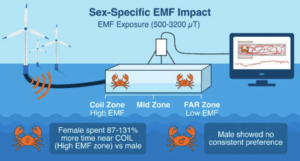As electric vehicles (EVs) have become more mainstream as people’s choice of a daily driver, a new concern has entered the conversation: EMF exposure in cars. With their powerful batteries, electric motors, and wireless connectivity, many drivers are left wondering: Are EVs safe from an electromagnetic radiation standpoint?

A comprehensive study published in 2025 by researchers in Japan helps answer that question. They measured and analyzed the electromagnetic fields (EMFs) present inside various types of vehicles, including fully electric, hybrid, and traditional gasoline-powered cars.
Understanding EMF in EVs
This study set out to compare EMF levels across different types of vehicles in real-world driving conditions. Researchers focused on:
- Static magnetic fields (SMFs)
- Extremely low frequency (ELF) fields from powertrain systems
- Radiofrequency (RF) fields from devices like smartphones and Wi-Fi
They tested vehicles while idling, accelerating, braking, and driving at low speeds—analyzing both the driver’s and passenger’s exposure to EMFs in various seating positions.
Key Findings: EMF Exposure in Cars is Real—But Is It Dangerous?
The research findings offer a reassuring baseline:
- EMF levels in all vehicles—including EVs—remained well below international safety standards set by the International Commission on Non-Ionizing Radiation Protection (ICNIRP) and the IEEE.
- The driver’s seat had slightly higher magnetic field exposure than the rear seat, mostly due to its proximity to the vehicle’s inverter and battery systems.
- RF exposure inside EVs came more from occupants’ personal devices (phones, tablets) than from the vehicle itself.
- Acceleration and braking slightly increased EMF output, but never to levels of concern based on current guidelines.
These findings suggest that EMF in EVs is present—but in amounts currently considered safe for short-term exposure.
What About Long-Term Use and Health Implications?
One of the study’s most unique aspects was its long-term monitoring. Researchers tracked some vehicles over two years and even re-tested EMF levels after repairs or part replacements. Interestingly:
- Replacing components like wheel hubs or motor parts altered magnetic field distribution inside the car, although still within recommended exposure limits.
- Routine maintenance had minimal effect on EMF levels, but highlights how parts and design changes can shift electromagnetic behavior inside the cabin.
Are EMF Cars Safe for People with Pacemakers?
To ensure the safety of sensitive individuals, the researchers simulated electromagnetic interactions with implanted pacemakers and other cardiac devices. Their modeling found:
- The induced electric fields, SAR (specific absorption rate), and tissue heating stayed far below ICNIRP limits.
- Even in close proximity to EV motors, pacemaker interference was not a risk under normal operating conditions.
This is a reassuring development for anyone managing a chronic health condition.
So, Are EMFs in Cars a Health Risk?
Based on the latest data, the answer is: not necessarily—especially in the short term.
All measured EMF values in electric and hybrid vehicles remained within international public exposure guidelines, even in situations involving acceleration or extended use. EMF exposure in cars is often lower than what we experience using our phones or laptops on a daily basis.
But Here’s the Caveat: Safety Limits Aren’t the Full Story
While ICNIRP and IEEE provide valuable reference levels, it’s important to note:
The “reference levels” set by ICNIRP only address acute effects from short-term exposure—such as nerve stimulation or heating—not long-term biological effects.
In other words, compliance with these guidelines does not guarantee long-term safety, especially with chronic, low-level exposure over years of driving or riding in a vehicle.
Given how much time many of us spend in our cars—whether commuting, traveling, or driving with children—this is important food for thought.
Understanding EMF in the Context of Your Daily Life
While the vehicle research provides crucial insights, it’s worth considering your car’s EMF exposure as part of your broader electromagnetic environment. Your daily EMF “budget” likely includes:
Your Home Environment
Your home probably represents your highest daily EMF exposure:
- Kitchen: Microwave ovens, induction cooktops, smart appliances
- Living spaces: Wi-Fi routers, smart TVs, streaming devices
- Bedrooms: Phone chargers, baby monitors, electric blankets
- Smart home systems: Wireless security, IoT devices, smart meters
Personal Device Usage
- Smartphones held close to the body throughout the day
- Wireless headphones and earbuds
- Tablets and laptops for work and entertainment
- Gaming devices and controllers
Children’s Exposure
- School-issued devices and tablets
- Higher usage rates than previous generations
- Developing nervous systems that may be more sensitive
- Longer lifetime exposure periods ahead
Work and Travel
- Office wireless networks and equipment
- Air travel with cosmic radiation and dense electronics
- Public transportation with electrical systems
- Industrial or healthcare environments
Making Informed Vehicle Choices
Understanding your complete daily EMF exposure helps put vehicle choices in perspective:
For Your Vehicle:
- Choose seating positions farther from the battery or inverter
- Research vehicles with lower reported ELF or RF levels
- Minimize use of wireless devices inside the car
- Consider your commute length and frequency
For Your Overall EMF Management:
- Prioritize high-impact areas: Focus on environments where you spend the most time
- Consider cumulative exposure: Your car is one piece of a larger electromagnetic puzzle
- Balance factors: EMF considerations alongside safety, convenience, and environmental concerns
- Stay informed: Follow research across all exposure sources, not just vehicles
Special Considerations for Sensitive Individuals
For those particularly sensitive to EMF or concerned about cumulative exposure, vehicle research findings should be considered alongside:
- Total daily exposure across all environments
- Individual sensitivity levels that may be below standard guidelines
- Duration and proximity factors in different settings
- Multiple EMF sources potentially interacting simultaneously
Stay Aware, Stay Informed
This 2025 study adds important, up-to-date insights to the discussion about EMF exposure in cars—especially EMF in EVs. Respected individuals like Dr. Joel Moskowitz from the Center of Family & Community Health at UC Berkeley are sharing their interest in these considerations. While modern vehicles appear to meet current safety thresholds, the conversation around long-term exposure, individual sensitivity, and biological effects is far from over.
For vehicle-specific protection, consider:
- Choosing seating positions farther from the battery or inverter
- Minimizing use of wireless devices inside the car
- Researching vehicles with lower reported ELF or RF levels
For comprehensive EMF awareness:
- Understand that your car is one part of your daily electromagnetic environment
- Make informed choices across all the environments where you spend significant time
- Focus on the areas with the highest exposure or longest duration
- Balance EMF considerations with other important factors like safety and lifestyle needs
Remember: EMF cars are here to stay—but knowledge is power. As we shift toward an electric future, let’s do so with clarity, care, and a watchful eye on how technology intersects with long-term wellness, both in our vehicles and throughout our daily lives.
For more information on the only trusted EMF solution I use for my family, and why I have prioritized my environmental health learn more here. Use code MOMSEMF for 25% off your order, exclusive to my community!







